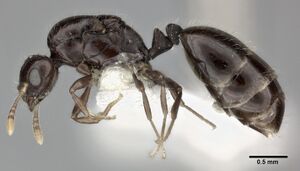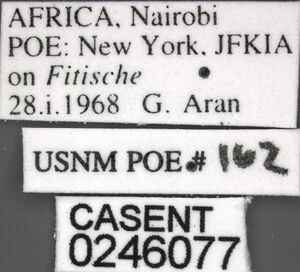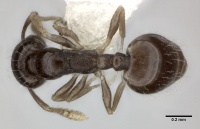Monomorium malatu
| Monomorium malatu | |
|---|---|

| |
| Scientific classification | |
| Kingdom: | Animalia |
| Phylum: | Arthropoda |
| Class: | Insecta |
| Order: | Hymenoptera |
| Family: | Formicidae |
| Subfamily: | Myrmicinae |
| Tribe: | Solenopsidini |
| Genus: | Monomorium |
| Species: | M. malatu |
| Binomial name | |
| Monomorium malatu Bolton, 1987 | |
| Synonyms | |
| |
Nothing is known about the biology of Monomorium malatu.
Identification
Bolton (1987) - A member of the M. malatu complex in the M. monomorium species group. M. malatu is a very distinctive species, closest related to the much smaller Monomorium affabile, the two being separated by both absolute and relative dimensions. These two share their characteristic cuneate petiole and high postpetiole with Monomorium dolatu, but here the antennae have only 11 segments. More distantly all appear related to Monomorium disoriente and Monomorium tanysum; see the notes under the latter name.
Keys including this Species
Distribution
Latitudinal Distribution Pattern
Latitudinal Range: -0.317° to -3.5°.
| North Temperate |
North Subtropical |
Tropical | South Subtropical |
South Temperate |
- Source: AntMaps
Distribution based on Regional Taxon Lists
Afrotropical Region: Central African Republic, Democratic Republic of Congo (type locality), Kenya, Uganda.
Distribution based on AntMaps
Distribution based on AntWeb specimens
Check data from AntWeb
Countries Occupied
| Number of countries occupied by this species based on AntWiki Regional Taxon Lists. In general, fewer countries occupied indicates a narrower range, while more countries indicates a more widespread species. |

|
Estimated Abundance
| Relative abundance based on number of AntMaps records per species (this species within the purple bar). Fewer records (to the left) indicates a less abundant/encountered species while more records (to the right) indicates more abundant/encountered species. |

|
Biology
Castes
Queen
Images from AntWeb
   
| |
| Queen (alate/dealate). Specimen code casent0246077. Photographer Andrea Walker, uploaded by California Academy of Sciences. | Owned by USNM, Washington, DC, USA. |
Nomenclature
The following information is derived from Barry Bolton's Online Catalogue of the Ants of the World.
- altinode. Tetramorium altinode Santschi, 1935a: 266, fig. 10 (w.) DEMOCRATIC REPUBLIC OF CONGO.
- Type-material: holotype worker.
- Type-locality: Democratic Republic of Congo: Matadi, x.1920 (L. Burgeon).
- Type-depository: MRAC
- [Junior secondary homonym of Monomorium rhopalocerum altinode Santschi, 1910c: 359.]
- Combination in Monomorium: Bolton, 1980: 199.
- Replacement name: Monomorium malatu Bolton, 1987: 399.
- malatu. Monomorium malatu Bolton, 1987: 399.
- Replacement name for Tetramorium altinode Santschi, 1935a: 266. [Junior secondary homonym of Monomorium rhopalocerum altinodis Santschi, 1910c: 359.]
- Status as species: Bolton, 1995b: 264; Hita Garcia, et al. 2013: 212.
- Distribution: Central African Republic, Democratic Republic of Congo, Uganda.
Unless otherwise noted the text for the remainder of this section is reported from the publication that includes the original description.
Description
Worker
TL 1.9-2.1, HL 0.42-0.52, HW 0.38-0.46, CI 88-92, SL 0.33-0.38, SI 80-85, PW 0.26-0.28, AL 0.50-0.54 (7 measured).
Prominent median section of anterior clypeal margin broad and subrectangular, the anterior margin transverse to shallowly concave between a pair of low broad slightly projecting angles which separate the anterior and lateral margins of the prominent median section of the clypeus. Clypeal carinae weakly developed, widely separated and subparallel, only slightly divergent anteriorly. Maximum diameter of eye 0.21-0.23 x HW and with 5-7 ommatidia in the longest row. With the head in full-face view the posterior margins of the eyes at the midlength of the sides and the scapes, when laid straight back, failing to reach the occipital margin. Head in full-face view short and broad (CI > 85), the sides slightly convex and the occipital margin transverse or very nearly so. Alitrunk in profile with promesonotum evenly domed-convex, highest at about the midlength and sloping evenly posteriorly to the weakly impressed metanotal groove. Propodeal dorsum with a short more or less horizontal section behind the metanotal groove; this is followed by a long shallow convex curve which slopes posteriorly and is confluent with the declivity proper. Propodeal spiracle small and pinhole-like. Node of petiole high and narrow in profile, cuneate, very narrowly rounded above; subpetiolar process a conspicuous flange. Postpetiole node slightly smaller than that of petiole, somewhat anteroposteriorly compressed and with a vertical anterior face. Postpetiole dorsum conspicuously more broadly rounded than petiole. In dorsal view both nodes transverse, very obviously broader than long. All dorsal surfaces of head and body densely clothed with short standing hairs, most or all of which are blunt or truncated apically, the promesonotum with 8-10 pairs. Head unsculptured except for hair-pits, some weak sculpture immediately behind the frontal lobes and a narrow sculptured track on the side of the head which connects the eye to the mandibular insertion. Sides of alitrunk densely reticulate-punctate everywhere except for the pronotum (which is mostly smooth) and a small clear patch in front of the propodeal spiracle. Metanotal groove with fine narrow cross-ribbing. Pronotal dorsum smooth; mesonotal dorsum mostly smooth but usually with some faint sculpture on extreme lateral portions; propodeum reticulate-punctate. Petiole and postpetiole nodes reticulate to reticulate-punctulate laterally; their anterior, dorsal and upper-posterior surfaces usually smooth. Gaster unsculptured except for hair-pits. Colour dark brown to blackish brown.
Type Material
Holotype worker, Zaire: Matadi, x. 1920 (L. Burgeon) (Musee Royal de I' Afrique Centrale) [examined].
References
- Bolton, B. 1987. A review of the Solenopsis genus-group and revision of Afrotropical Monomorium Mayr (Hymenoptera: Formicidae). Bulletin of the British Museum (Natural History). Entomology. 54: 263-452.. (page 399, Replacement name for Tetramorium altinode Santschi, 1935a)
- Santschi, F. 1910c [1909]. Formicides nouveaux ou peu connus du Congo français. Ann. Soc. Entomol. Fr. 78: 349-400 (page 359, primary homonym)
- Santschi, F. 1935a. Fourmis du Musée du Congo Belge. Rev. Zool. Bot. Afr. 27: 254-285 (page 266, [Junior secondary homonym of Monomorium rhopalocerum var. altinodis Santschi, 1910c: 359.)
References based on Global Ant Biodiversity Informatics
- Bolton B. 1987. A review of the Solenopsis genus-group and revision of Afrotropical Monomorium Mayr (Hymenoptera: Formicidae). Bulletin of the British Museum (Natural History). Entomology 54: 263-452.
- Garcia F.H., Wiesel E. and Fischer G. 2013.The Ants of Kenya (Hymenoptera: Formicidae)Faunal Overview, First Species Checklist, Bibliography, Accounts for All Genera, and Discussion on Taxonomy and Zoogeography. Journal of East African Natural History, 101(2): 127-222

